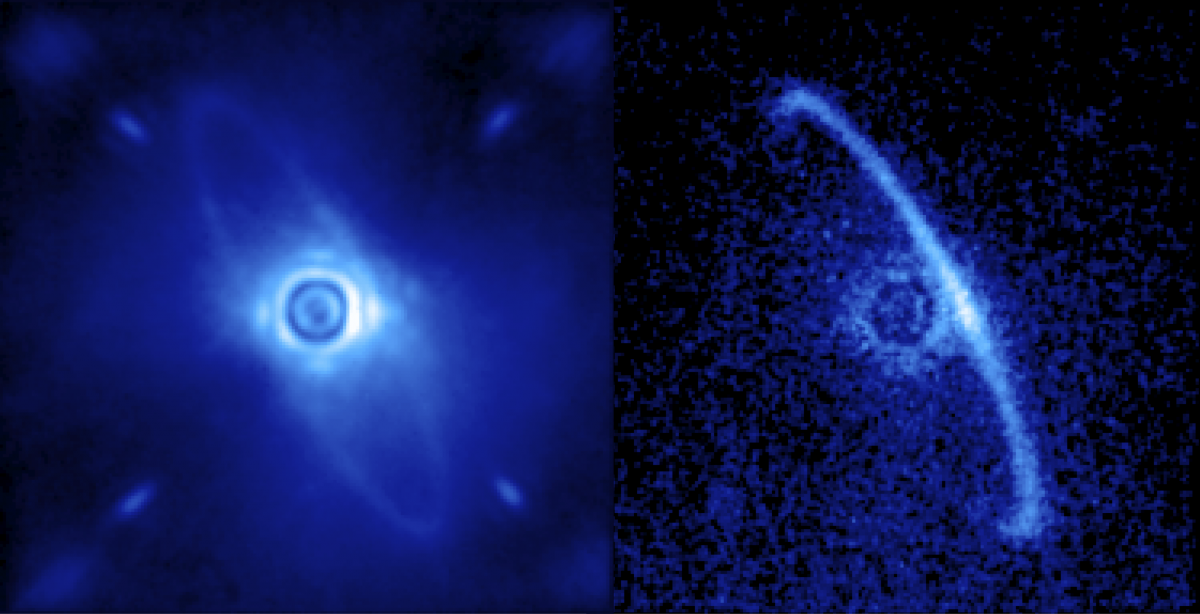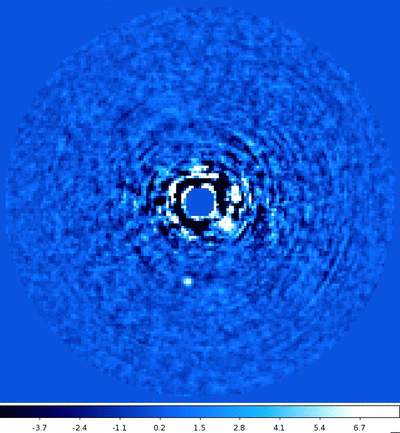- Gemini Observatory press release
- Keck Observatory press release
- UC Berkeley press release
- SETI Institute press release
- STSCI news release
- Stony Brook press release
- University of Arizona press release
Stanford press summary: The first planet detected by the Gemini Planet Imager is 100 light years away but shares many of the characteristics of an early Jupiter. Stanford Physics Professor Bruce Macintosh, the lead investigator on the instrument, explains how this planet could help understand how solar systems formed.
One of the best ways to learn how our solar system evolved is to look to younger star systems in the early stages of development. Now, a team of astronomers has discovered a Jupiter-like planet within a young system that could serve as a decoder ring for understanding how planets formed around our Sun.
The new planet, called 51 Eridani b, is the first exoplanet discovered by the Gemini Planet Imager, a new instrument operated by an international collaboration headed by Bruce Macintosh, a professor of physics in the Kavli Institute at Stanford. It is a million times fainter than its star and shows the strongest methane signature ever detected on an alien planet, which should yield additional clues as to how the planet formed.
The results are published in the current issue of Science.
A clear line of sight
The Gemini Planet Imager (GPI) was designed specifically for discovering and analyzing faint, young planets orbiting bright stars. NASA’s Kepler mission indirectly discovers planets by the loss of starlight when a planet blocks a star. ‘To detect planets, Kepler sees their shadow; GPI sees their glow,’ said Macintosh. What GPI does is referred to as direct imaging. The astronomers use adaptive optics to sharpen the image of a star, and then block out the starlight. Any remaining incoming light is then analyzed, the brightest spots indicating a possible planet.
After GPI was installed on the 8-meter Gemini South Telescope in Chile, the team set out to look for planets orbiting young stars. They’ve looked at almost a hundred stars so far. “This is exactly the kind of planet we envisioned discovering when we designed GPI”, says James Graham, professor at UC Berkeley and Project Scientist for GPI.
As far as the cosmic clock is concerned, 51 Eridani is young – only 20 million old – and this is exactly what made the direct detection of the planet possible. When planets coalesce, material falling into the planet releases energy and heats it up. Over the next hundred millions years they radiate that energy away, mostly as infrared light.
Once the astronomers zeroed in on the star, they blocked its light and spotted 51 Eri b orbiting a little farther away from its parent star than Saturn does from the sun. The light from the planet is very faint – more than one million times fainter than it star – but GPI can see it clearly. Observations revealed that it is roughly twice the mass of Jupiter. Other directly-imaged planets are five times the mass of Jupiter or more.

An artistic conception of the Jupiter-like exoplanet, 51 Eri b, seen in the near-infrared light that shows the hot layers deep in its atmosphere glowing through clouds. Because of its young age, this young cousin of our own Jupiter is still hot and carries information on the way it was formed 20 million years ago.
credits: Danielle Futselaar & Franck Marchis, SETI Institute
In addition to being the lowest-mass planet ever imaged, it’s also one of the coldest – 800 degrees Fahrenheit, whereas others are around 1,200 F – and features the strongest atmospheric methane signal on record. Previous Jupiter-like exoplanets have shown only faint traces of methane, far different from the heavy methane atmospheres of the gas giants in our solar system.
All of these characteristics, the researchers say, point to a planet that is very much what models suggest Jupiter was like in its infancy.
“Many of the exoplanets astronomers have studied before have atmospheres that look like very cool stars” said Macintosh. “This one looks like a planet.”
Of course, it’s not exactly like Jupiter. The planet is so young still has a temperature of 700 Fahrenheit, hot enough to melt lead. “In the atmospheres of the cold giant planets of our solar system carbon is found as methane, unlike most exoplanets where carbon has mostly been found in the form of carbon monoxide. Since the atmosphere of 51 Eri b is also methane rich, it signifies that this planet is well on its way to becoming a cousin of our own familiar Jupiter. “ said Mark Marley, an astrophysicist at NASA’s Ames research center.
The key to the solar system?
In addition to expanding the universe of known planets, GPI will provide clues as to how solar systems form. Astronomers believe that the gas giants in our solar system formed by building up a large, core over a few million years and then pulling in a huge amount of hydrogen and other gasses to form an atmosphere. But the Jupiter-like exoplanets that have so far been discovered are much hotter than models have predicted, hinting that they could have formed much faster as material collapses quickly to make a very hot planet. This is an important difference. The core-buildup process can also form rocky planets like the Earth; a fast and hot collapse might only make giant gassy planets. 51 Eridani b is young enough that it ‘remembers’ its formation.

Discovery image of 51 Eri b with the Gemini Planet Imager taken in the near-infrared light on December 18 2014. The bright central star has been mostly removed by a hardward and software mask to enable the detection
of the exoplanet one million times fainter. Credits: J. Rameau (UdeM) and C. Marois (NRC Herzberg)
“51 Eri b is the first one that’s cold enough and close enough to the star that it could have indeed formed right where it is the ‘old-fashioned way,'” Macintosh said. “This planet really could have formed the same way Jupiter did – this whole planetary system could be a lot like ours.”
There are hundreds of planets a little bigger than Earth out there, Macintosh said, but there is so far no way to know if they are really “super-Earths” or just micro-sized gas and ice planets like Neptune or something different all together. Using GPI to study more young solar systems such as 51 Eridani, he said, will help astronomers understand the formation of our neighbor planets, and how common that planet-forming mechanism is throughout the universe.

